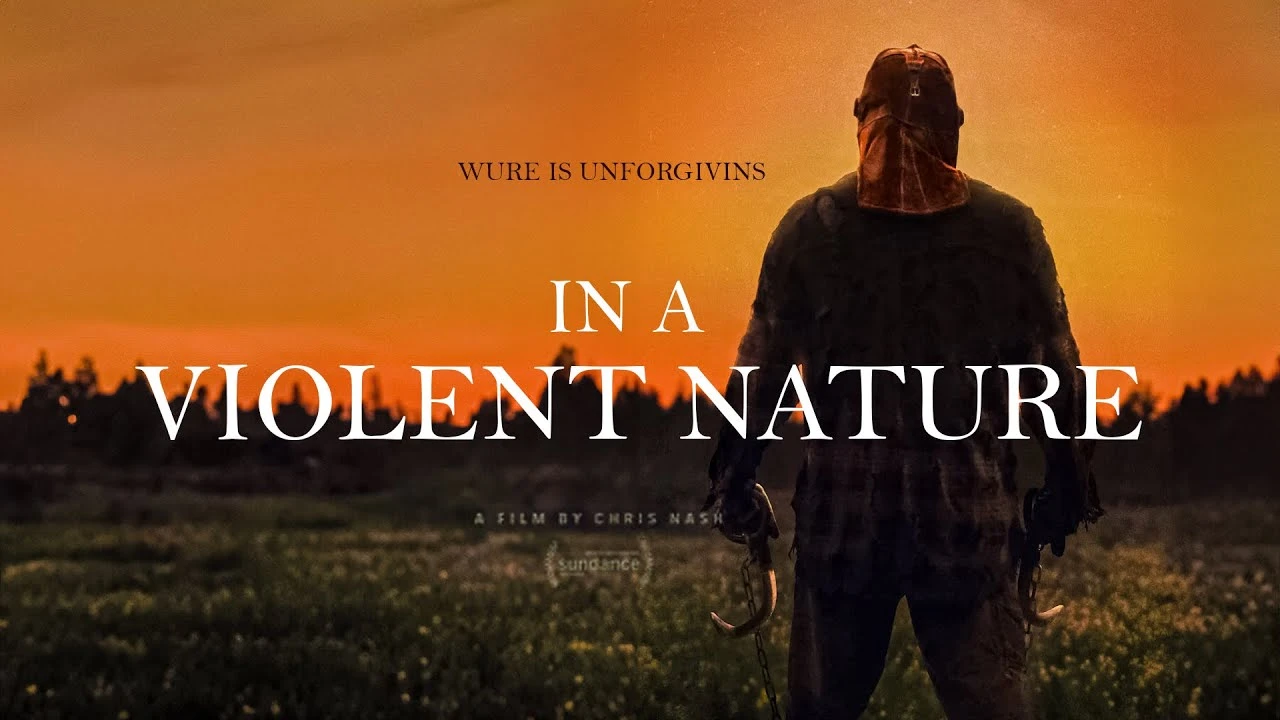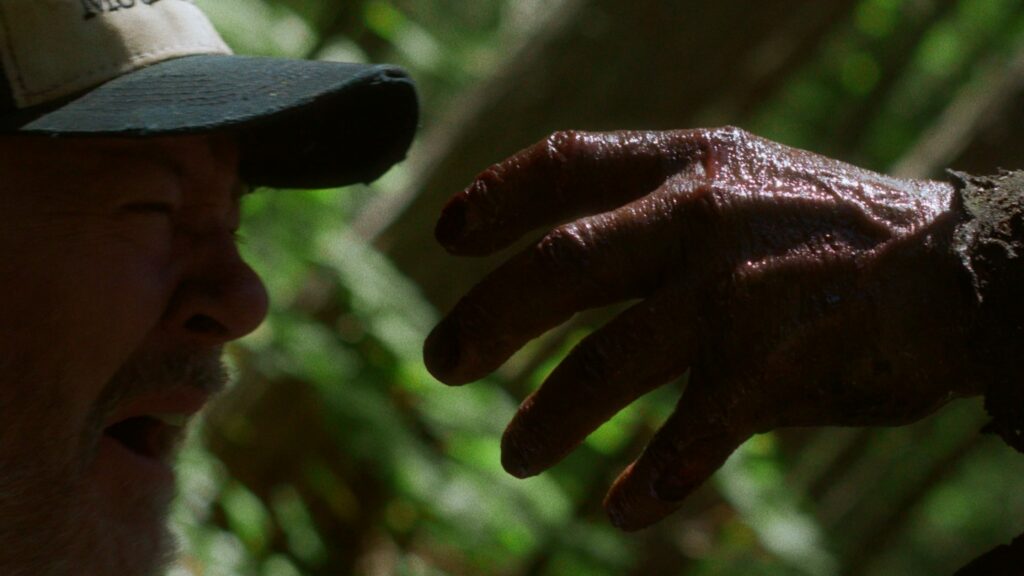
In a Violent Nature (2024)
- by admin
- Posted on 18 August, 2024
Fridays of heaven
It’s a cheeky and intriguing pitch, I’ll give Chris Nash that much: What if a Friday the 13th movie was filmed from Jason Voorhees’ perspective in pseudo-slow cinema with pseudo-Malick nature photography? What if the horny teens and their idiocy and even their jump scares were just on the periphery of the film, the main subject the plodding but precise killer?
The answer, apparently, is: You get a fascinating experiment. That is the lens by which In a Violent Nature is most successful: an intriguing execution for a goofy “what if” question. And I’ll give it credit for that. It isn’t “experimental cinema” by any stretch, but it does push the outer boundary of slashers, i.e. the most rigidly-structured and trope-bound subgenre of horror that is, to quote my Friday the 13th review, “so ripe for repetition, innovation, and eventually parody.” In a Violent Nature does this admirably: it inspires you to think a little bit more about the movies that inspired it (much more than it inspires you to actually experience, watch, and enjoy it on its own terms). I was engaged and curious the whole time, and I spent a lot of the runtime imagining what this movie might look like if it were a “traditional” slasher (the answer, as noted, is it would be almost exactly a Friday the 13th). I also wondered, more abstractly, if and what this has to say about slashers as a cinematic form and a vessel for ideas. I don’t think In a Violent Nature really does have much in the way of metacommentary (hell, Friday the 13th Part 4 might be more introspective than this), but it’s at least fun to engage with as a thought exercise.

But I also must point out that, as much as it exists as an “exercise,” the film cuts some corners in its experiment in order to remain a watchable and enjoyable horror film proper. This makes it less of a dedicated, wacko curiosity but more of an actual piece of entertainment. It suggests that its somewhat radical aesthetic approach is more window dressing than it is actual dedicated piece of formalism. Slasher is as slasher does, even if we get lots of tromping around and over-the-shoulder shots.
There’s enough irony baked into the premise such that it is essentially a comedy. The tone is detached and subdued, but you’re still always thinking “I can’t believe I’m watching an arty-ass Friday the 13th; it’s so goofy,” which makes it funny even though it’s not a funny movie. Except it sometimes actually is funny. Specifically, a few of the kills are ludicrous pieces of body horror that circle so far back from gory to wacky that Nash has tipped his hand. He wants us to laugh in astonishment at this film he’s created. (The gore effects, by the way, are sensational.)
The presentation, at least, is quite nice. The gorgeous shots of woods in day and night, directly inspired by Terrence Malick according to Nash, are indeed rapturous. The sound design of nature is terrific, too, squishy and crunchy and rustling. (My one big beef with the sound design is that the characters’ voices are mixed too loud and clear; it’s not like what they’re saying matters too much, so I wish Nash had just let the voices be sounds wind-carried and distant to enhance the naturalism of wandering the woods and stumbling upon a distant crowd.)

Some of my film-geek friends have complained about the aspect ratio (truly one of the great film-geek pastimes), which is a boxy 1.33:1. I didn’t expect to agree with them, but I did: the movie would work better in a sprawling widescreen format so that we feel surrounded and all-consumed by the nature around us. Our pal Hunter at Kinemalogue suggests (then rejects) the idea that Nash wanted to invoke the VHS or early cable TV frame the way that many of us discovered B-rate horror movies like the ones that this is parodying. But everything else about the presentation and texture is rejecting the cheap presentation of those films, so I think the aspect ratio should have done the same.
If Friday the 13th is the genre and narrative reference, and Malick is the aesthetic reference, the third key connection is Gus Van Sant. Even more than In a Violent Nature is a “slow cinema slasher” — since this really isn’t slow cinema at all — this film is “Elephant but about a slasher massacre instead of a school shooting.” In a Violent Nature adopts Elephant’s formal schema of long tracking shots where we follow the back of a character walking, as if playing a third-person perspective video game. In Elephant it was a way of toying with the humanity and narrative agency of various characters in a Columbine-esque shooting; here, it’s to toy with the monstrous brutality of a masked undead murderer, desaturating the story of its horror texture. The result of both films is to juxtapose the calm rhythms of its filmmaking with the horrifying story content in a way that unsettles us and shakes us out of our familiar emotional engagement with its material.

Where the film flies off the rail is in the final act. You know what’s coming: the final girl chase. Instead of sticking to the gambit of the film leading up to it, Nash tries something radically different in these closing minutes. Parts of it work: we shift to a more subjective experience with more heightened sensory details: e.g., the nature foley ramps up to hyper-real volumes in a disorienting way, and the editing becomes suddenly elliptical. I was thrown off in a curious sort of way, for the first time unsure of what we would see next. But what actually happens on screen — or, more to the point, doesn’t happen on screen — belongs in a different movie. The first 70 minutes of In a Violent Nature are a slasher playing dress-up as a totally different genre, depicting the tropes but with a different look-and-feel; the last 15, by contrast, are an anti-slasher, discarding the tropes as if this really were experimental cinema. (And, just to remind us we’re watching an arty horror film in the 2020s, it lets us know that this whole thing is at least a little bit about trauma.)
So after all of that is done, I don’t know quite how to evaluate In a Violent Nature, but I enjoyed it enough and have thought about it enough since watching that I think I have to give it a soft passing grade even if it’s not ever scary, rarely even suspenseful, and it cops out of its premise a bit too much. I always enjoy a good high-concept slasher remix, though typically I mean that about the narrative (Happy Death Day, Freaky, Totally Killer) rather than the presentation. Honestly, a soft thumbs up feels right — that puts it above the mediocre and bad Fridays but a bit below the ones I actually liked (2, 4, and 6).
Fridays of heaven It’s a cheeky and intriguing pitch, I’ll give Chris Nash that much: What if a Friday the 13th movie was filmed from Jason Voorhees’ perspective in pseudo-slow cinema with pseudo-Malick nature photography? What if the horny teens and their idiocy and even their jump scares were just on the periphery of the film, the…